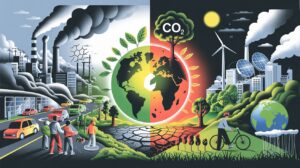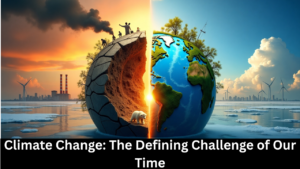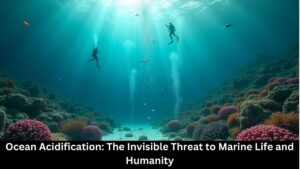Rising sea levels, driven by climate change, are one of the most pressing and irreversible threats to humanity. From submerged coastlines to displaced communities, this slow-motion disaster is already altering the planet’s geography and threatening the livelihoods of millions. With global sea levels rising at an accelerating rate—3.7 millimeters annually since 2006, up from 1.4 mm/year in the 20th century (NASA)—the urgency to understand and address this crisis has never been greater.
Table of Contents
ToggleThe Science Behind Rising Sea Levels
Rising sea levels are primarily caused by two factors linked to global warming:
- Thermal Expansion: As oceans absorb 90% of the excess heat trapped by greenhouse gases, seawater expands. This phenomenon alone accounts for about 50% of sea level rise since 1970 (NOAA).
- Melting Ice Sheets and Glaciers: The Greenland and Antarctic ice sheets are losing mass at alarming rates. Greenland shed an average of 279 billion tons of ice annually from 1993 to 2019, while Antarctica lost 148 billion tons per year (IPCC). Glaciers from the Himalayas to the Alps are retreating, adding billions of tons of freshwater to oceans.
Human activities, particularly the burning of fossil fuels and deforestation, have increased atmospheric CO₂ concentrations to 420 ppm—the highest in 4 million years (Scripps Institution). This warming destabilizes Earth’s cryosphere and fuels the cycle of rising seas.
Impacts: A World Underwater
1. Coastal Cities at Risk
By 2100, up to 630 million people could live in flood-prone coastal zones if emissions remain unchecked (Climate Central). Major cities like Miami, Shanghai, and Mumbai face existential threats:
- Miami, USA: Saltwater intrusion contaminates drinking water, while “sunny day flooding” now occurs 10 times more often than in the 2000s (Union of Concerned Scientists).
- Jakarta, Indonesia: The sinking megacity, which loses 25 cm of elevation annually due to groundwater extraction, is relocating its capital to Borneo (BBC).
2. Small Island Nations on the Frontlines
Low-lying nations like the Maldives, Tuvalu, and Kiribati could become uninhabitable by 2050. Kiribati has already purchased land in Fiji as a climate refuge for its 120,000 residents (The Guardian).
3. Ecological Collapse
- Wetlands and Mangroves: These natural barriers against storm surges are drowning as seas rise faster than they can migrate inland (WWF).
- Coral Reefs: Higher sea levels exacerbate coastal erosion, while warming and acidification bleach reefs that protect shorelines (NOAA).
The Human Cost: Climate Migration and Inequality
Rising seas disproportionately impact marginalized communities. By 2050, 216 million people could be displaced within their own countries due to climate impacts, including sea level rise (World Bank). In Bangladesh, where 40% of the population lives in coastal regions, 18 million may flee rising tides by 2050 (UNDP).
Meanwhile, wealthy nations and corporations—responsible for the majority of emissions—often invest in seawalls and infrastructure, leaving poorer regions to face displacement without resources. This climate injustice is a growing ethical crisis.
Solutions: Mitigation, Adaptation, and Innovation
1. Cutting Emissions
Achieving net-zero emissions by 2050 is critical to limiting sea level rise to 0.5 meters by 2100 (vs. 2 meters under high emissions) (IPCC). Key steps include:
- Phasing out fossil fuels and scaling up renewable energy like offshore wind and tidal power.
- Restoring coastal ecosystems like mangroves, which sequester 4x more carbon than rainforests (IUCN).
2. Engineering Resilience
- Seawalls and Barriers: The Netherlands’ Delta Works and Venice’s MOSE project showcase engineered defenses. However, these are costly and temporary fixes.
- Floating Cities: Concepts like Oceanix City propose modular, flood-resistant urban areas (UN-Habitat).
3. Managed Retreat
Relocating communities from high-risk zones is inevitable in regions like Louisiana, where 2,000 square miles of land have vanished since 1930 (USGS). Equitable relocation plans must prioritize vulnerable populations.
Global Cooperation: The Role of Policy
The Paris Agreement aims to limit warming to 1.5°C, but current pledges put the world on track for 2.7°C (UNEP). Strengthening international frameworks is vital:
- Funding Adaptation: Developed nations pledged $100 billion annually to help low-income countries adapt, but commitments remain unfulfilled (OECD).
- Legal Accountability: Small island states are pushing for climate reparations through international courts (ICJ).
Read Also: 50 Global Warming Slogans to Inspire Action
Conclusion: A Race Against Time
Rising sea levels are not a distant threat—they are reshaping lives today. While the challenge is immense, solutions exist. From restoring ecosystems to reimagining coastal cities, humanity must act swiftly and equitably. As UN Secretary-General António Guterres warns, “We are in a battle for our lives. But it is a battle we can win
Explore Further:






